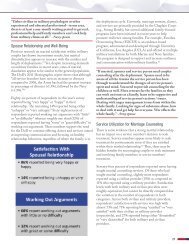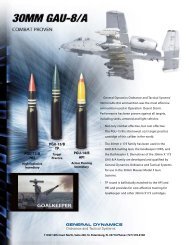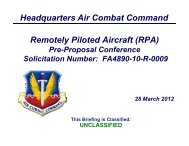F-35 Joint Strike Fighter (JSF) - WordPress.com
F-35 Joint Strike Fighter (JSF) - WordPress.com
F-35 Joint Strike Fighter (JSF) - WordPress.com
Create successful ePaper yourself
Turn your PDF publications into a flip-book with our unique Google optimized e-Paper software.
DOD PROGRAMS<br />
• The status of F-<strong>35</strong>B door and propulsion deficiencies follows.<br />
- The upper lift fan inlet doors continue to fail to operate<br />
correctly due to poor actuator design. Crews have<br />
observed failure of the doors to close on flight test aircraft<br />
and the early LRIP aircraft at Eglin AFB during ground<br />
operations. Ground maintenance workaround procedures<br />
are in place to ensure correct door operation; however,<br />
standard maintenance procedures for fleet operations<br />
are not yet in place. Newly designed actuators will not<br />
be available for production cut-in until BF-38, a Lot 6<br />
delivery in 2014.<br />
- Redesign of the auxiliary air inlet doors is <strong>com</strong>plete. The<br />
test team ac<strong>com</strong>plished flight testing of the aerodynamic<br />
loads on the BF-1 doors early in 2012, and modified<br />
the F-<strong>35</strong>B static test article with the new auxiliary air<br />
inlet doors in August 2012 in preparation for static and<br />
durability testing. The static load testing was <strong>com</strong>pleted in<br />
mid-November, followed by the start of durability testing.<br />
Results of the testing were not available as of the time of<br />
this report.<br />
- Testing and analysis continued on the three-bearing swivel<br />
nozzle doors. The test team added instrumentation on<br />
BF-1 in January to assess the dynamic loads on the door<br />
to support an engineering redesign. BF-2 was modified<br />
and flight testing of the design is ongoing as of the time of<br />
this report. Redesign for both the production cut-in and<br />
the retrofit plans is in review at the Program Office. Fleet<br />
restrictions will remain in effect (slow landings below<br />
100 KCAS are prohibited) until the program modifies the<br />
nozzle doors.<br />
- Temperatures in the roll control nozzle actuator area<br />
exceeded the heat tolerance of the current actuator design<br />
during flight test, necessitating a redesign. The program<br />
is changing the insulation in the nozzle actuator area as an<br />
interim fix and redesigning the nozzle actuator to improve<br />
heat tolerance. The program plans to begin testing the<br />
newly designed nozzle actuator in early 2013.<br />
- After roll control nozzle doors separated in-flight in 2011,<br />
additional testing of the aerodynamic loads on the doors<br />
led to a door redesign. A production redesign currently<br />
under review with the Program Office increases the closing<br />
forces on the door to prevent aerodynamic loads opening<br />
and possibly damaging doors or causing door separation.<br />
- The material solution to unacceptably high clutch<br />
temperatures observed during developmental testing is to<br />
reduce the width of the clutch plates in later LRIP aircraft<br />
with the expectation of reducing the drag and associated<br />
heating during all modes of flight. Clutch temperatures are<br />
monitored by aircraft sensors, which alert the pilot when<br />
normal temperature limits are exceeded. The associated<br />
pilot procedures to reduce high clutch temperatures require<br />
changing flight regimes to a cooling envelope of lower<br />
altitude (below 11,000 feet) and lower airspeed (less than<br />
280 knots); such a procedure during <strong>com</strong>bat missions<br />
would likely increase the vulnerability to threats and cause<br />
the pilot to abort the mission. Further, a vertical landing<br />
under high clutch temperature conditions needs to be<br />
avoided if possible, making return to forward basing or<br />
ship-borne operations in the <strong>com</strong>bat zone, where a vertical<br />
landing would be required, not practical.<br />
- The program added spacers to the lift fan driveshaft to<br />
address unanticipated expansion/stretching that takes<br />
place during flight. This is an interim solution while the<br />
program redesigns the driveshaft for better performance<br />
and durability.<br />
• Weight management of the F-<strong>35</strong>B aircraft is critical to<br />
meeting the Key Performance Parameters (KPPs) in the<br />
ORD, including the vertical lift bring-back requirement. This<br />
KPP requires the F-<strong>35</strong>B to be able to fly an operationally<br />
representative profile and recover to the ship with the<br />
necessary fuel and balance of unexpended weapons (two<br />
1,000-pound bombs and two AIM-120 missiles) to safely<br />
conduct a vertical landing.<br />
- Weight reports for the F-<strong>35</strong>B have varied little in<br />
2012, increasing 14 pounds from either changes<br />
in the manufacturing processes or more fidelity in<br />
the weight estimate. Current estimates are within<br />
231 pounds (0.71 percent) of the not-to-exceed weight<br />
of 32,577 pounds – the target weight of the aircraft in<br />
January 2015 to meet specification requirements and<br />
ORD mission performance requirements for vertical lift<br />
bring‐back. The small difference between the current<br />
weight estimate and the not-to-exceed weight allows for<br />
weight growth of 0.32 percent per year.<br />
- Managing weight growth with such small margins will<br />
continue to be a significant program challenge. Since<br />
the program will conduct the technical performance<br />
measurement of the aircraft in January 2015, well before<br />
the <strong>com</strong>pletion of SDD, continued weight growth through<br />
the balance of SDD will affect the ability of the F-<strong>35</strong>B<br />
to meet the STOVL mission performance KPP during<br />
IOT&E. Additionally, production aircraft are weighed as<br />
part of the government acceptance process, and the early<br />
LRIP lot F-<strong>35</strong>B aircraft were approximately 150 pounds<br />
heavier than the predicted values found in the weight status<br />
report.<br />
• The program announced an intention to change performance<br />
specifications for the F-<strong>35</strong>B, reducing turn performance from<br />
5.0 to 4.5 sustained g’s and extending the time for acceleration<br />
from 0.8 Mach to 1.2 Mach by 16 seconds. These changes<br />
were due to the results of air vehicle performance and flying<br />
qualities evaluations.<br />
• Other discoveries included:<br />
- As with the F-<strong>35</strong>A, horizontal tail surfaces are<br />
experiencing higher than expected temperatures during<br />
sustained high-speed/high-altitude flight, resulting in<br />
delamination and scorching of the surface coatings<br />
and structure. The program modified the tail surfaces<br />
of BF-2 in September to permit flight testing at higher<br />
airspeeds. The coatings delaminated during flight,<br />
32 F-<strong>35</strong> <strong>JSF</strong>






